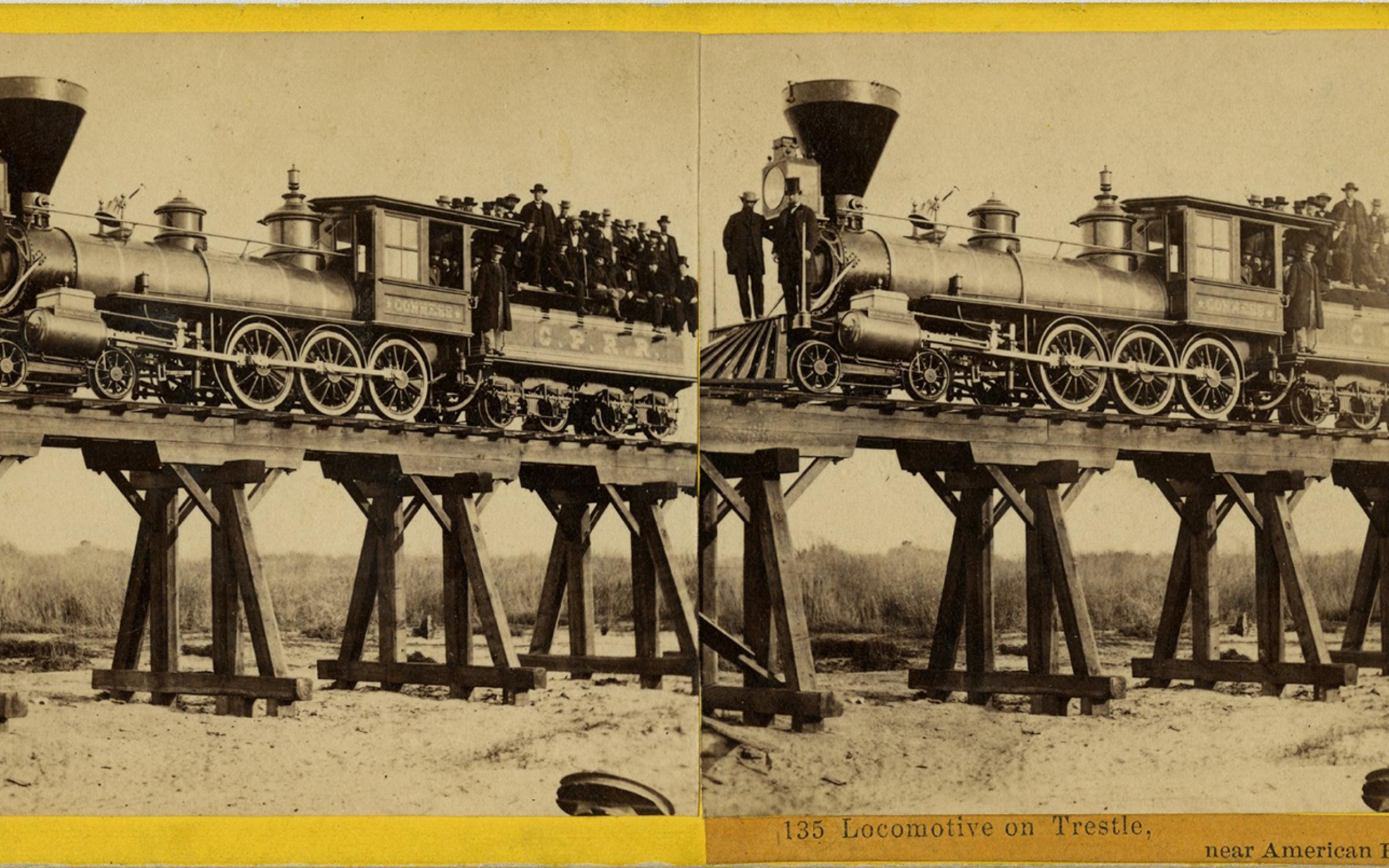
The Race to Promontory: The Transcontinental Railroad and the American West is a major traveling exhibition celebrating the 150th anniversary of the “Meeting of the Rails” at Promontory Summit, Utah, on May 10, 1869, with original photographs, historic artifacts, and one of the famous ceremonial spikes.
The Race to Promontory offers an extraordinary account of one of the greatest achievements of the nineteenth century through powerful images that still resonate a century and a half after their making. The exhibition also reunited, for the first time in Utah, the famous Golden (The Last Spike), Nevada Silver, and Arizona spikes present when the railroad was completed. The Golden and Nevada Silver spikes are now on view at the Utah State Capitol. The Arizona spike is on view at the UMFA through May 26, when The Race to Promontory closes.
The exhibition, organized by Joslyn Art Museum and the Union Pacific Railroad Museum, is a cultural centerpiece of Spike 150, the state’s year-long celebration of the anniversary. Listen to Leslie Anderson, curator of European, American, and regional art, describe what you'll see in The Race to Promontory on KUED's Contact with Mary Dickson. Anderson curated The Race to Promontory for Salt Lake City, including the companion exhibition Charles Savage: Pioneer(ing) Photographer.
The Race to Promontory is a special ticketed exhibition. Click here for admission prices, Museum hours, and other information to help plan your visit.
The transcontinental railroad connected East and West, triggering dramatic economic, technological and cultural changes, from how fast people could travel across the country to what we eat and how we tell time. Fittingly, this transformative event was captured by the equally groundbreaking medium of photography, which not only documented the work but also captured the moment of the railroad’s completion and distributed it around the world. It was the first major news event carried “live.” Telegraph wires were attached to one of the ceremonial spikes, and as it was gently tapped with a silver maul, the “strokes” were heard across the country.
In The Race to Promontory visitors can explore more than 150 rare photographs and stereographs by Andrew Joseph Russell (1830–1902) and Alfred A. Hart (1816–1908), drawn exclusively from the Union Pacific Historic Collection at the Union Pacific Railroad Museum, the world’s largest collection of original photographs documenting the construction of the railroad between 1866 and 1869. The UMFA exhibition also includes thirty-one works by nineteenth-century Utah photographer Charles Savage, who composed scenes of the railroad and local landscapes to boost tourism and settlement. Savage’s photographs are on loan from J. Willard Marriott Library Special Collections at the University of Utah.
The Race to Promontory explores how these important American photographers framed the construction of the railroad for their nineteenth-century audiences: focusing primarily on the engineering triumphs of the railroad, the vast resources available for an expanding nation, and the region’s pictorial beauty. Interpretive materials, an interactive space in the exhibition, and a diverse offering of free programs give visitors a wide-angle lens through which to examine many narratives only alluded to in the works of Hart, Russell, and Savage.
Exhibition-related programs (see schedule below) feature renowned historians, thinkers, and community members who will highlight historically overlooked perspectives and stories: those of Chinese and Irish immigrants who made up the workforce, members of the Church of Latter-Day Saints who worked alongside them, and Native Americans, whose lives were forever changed as new migration spurred by the railroad hastened the end of the Indian Wars and the beginning of the reservation era. Read The Salt Lake Tribune article on the efforts of UMFA and other Spike 150 organizations to tell a broader range of stories, especially those of Chinese railroad workers, around this important event.
The UMFA recognizes that while this public programming creates opportunities for further sharing and discussion, not every important story is being told—including those of many indigenous people across the country upon whose land the railroad was constructed.
The Race to Promontory: The Transcontinental Railroad and the American West is on view at the UMFA February 1 through May 26. The exhibition is traveling to three stops along the route of the transcontinental railroad: it opened in Omaha, Nebraska, at the Joslyn in fall 2018 and will travel to the Crocker Art Museum in Sacramento, California, after its UMFA run.
Presenting Sponsor:
George S. and Dolores Doré Eccles Foundation
Golden Spike Sponsor:
Zions Bank
Programming & Lecture Sponsor:
The Hal R. and Naoma J. Tate Foundation
Additional funding provided by:
Union Pacific, the State of Utah, the Utah Department of Heritage and Arts, Spike150
Race to Promontory Public Programming
Discovering History through a Photograph: One Picture, Eight People, and the Unexpected Stories of American Life | Martha A. Sandweiss
Saturday, February 16 | 11 am | Katherine W. and Ezekiel R. Dumke Jr. Auditorium |
Exhibition admission is free all day Saturday, February 16.
Third Saturday for Families: Drawing with Photographs
Saturday, February 16 | 1–4 pm | FREE | Emma Eccles Jones Education Center Classroom Exhibition admission is free all day Saturday, February 16.
Promontory Perspectives: A Faculty Conversation
Wednesday, March 6 | 7 pm | Katherine W. and Ezekiel R. Dumke Jr. Auditorium |
Exhibition admission is free all day Wednesday, March 6.
ACME Session | Railroad Stories: Community Voices and Regional Perspectives
Wednesday, March 20 | 6:30 pm | FREE
Talks & Lectures | Charles Savage: Pioneer(ing) Photographer | Leslie Anderson, UMFA curator of European, American, and regional art
Wednesday, April 10 | 7 pm |Katherine W. and Ezekiel R. Dumke Jr. Auditorium | FREE
Talks & Lectures | Working on the Railroad: Chinese Workers and America’s First Transcontinental Line | Gordon H. Chang
Wednesday, May 8 | 7 pm |Katherine W. and Ezekiel R. Dumke Jr. Auditorium | FREE
